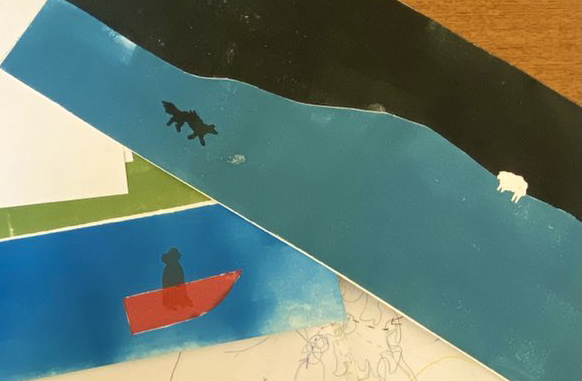Teaching Philosophy with Non-Linguistic Media
We have students read books and articles, write essays, answer test questions, and make presentations. These all mainly involve words. Is it worth thinking about how to teach philosophy in ways that don’t involve words?

[image via Handling Ideas]
the mere attempt to transform written thoughts into images or to combine these two media can afford a more holistic understanding of various issues… Every now and then I have been trying to encourage students to make use of drawings, tables, graphs or other sorts of tools in their writing. We are obviously inclined to employ different styles of reasoning in keeping with our diverging talents or backgrounds. As Frege argued in his Begriffsschrift, we clearly see different aspects of thoughts when using different graphic representations of logical inferences.
Here’s a teaching experiment he tried in his course, Medieval Theories of Thinking:
I wrote to my students a day before class asking them to bring coloured pencils, then handed out sheets of drawing paper and requested them to prepare infographics on the spot. I divided the students in three groups. One had to depict a conceptual distinction or problem, another had to depict a debate, and yet another had to depict a historical development. After chosing a topic, they had about thirty minutes to produce their work and then present (a) on the topic depicted and (b) on the experience afforded through the task. The outcomes were amazing.
Some benefits of exercises like this, he notes, include:
- giving a set of students, besides the highly verbal, an opportunity to shine in class
- forcing the students to show an understanding of the material without being able to parrot back what they’ve read or what the instructor has said
- providing new ways for students to connect with or anchor the ideas they’re learning about.
You can read more from Professor Lenz on this here.
I’m curious if others have attempted teaching philosophy through images and other primarily non-linguistic media and assignments, what students have thought of them, how effective you thought they were, concerns you have about them, and so on. Discussion welcome.


I have been experimenting with using various types of contemplative body practice (e.g., yoga, taijiquan, qigong) in academic philosophy classes. One place I wrote about this work is in an APA “Syllabus Showcase” back in 2022: https://blog.apaonline.org/2022/04/20/syllabus-showcase-yoga-and-philosophy-steve-geisz/
And another place was in “Body Practice and Meditation as Philosophy: Teaching Qigong, Taijiquan, and Yoga in College Courses” (Teaching Philosophy, Volume 39, Issue 2, June 2016): https://www.pdcnet.org/teachphil/content/teachphil_2016_0039_0002_0115_0135
Who has *not* used a Venn diagram?
I like coupling the two; it all started with taking Nietzsche seriously about walking and thinking. Environment became an obvious factor I hadn’t really considered.
Philosophy of history with TIMELINES:
https://philpapers.org/archive/CHADOT-7.pdf
Propositional logic with SOUNDS:
https://philpapers.org/archive/CHASR-5.pdf
Teaching argument DIAGRAMS to a student who is blind:
https://philpapers.org/archive/CHATAD-11.pdf
Why images can’t be arguments, but MOVING IMAGES might:
https://philpapers.org/archive/CHAWIC-2.pdf
Philosophy of technology with FILMS:
https://marcchampagnephilosopher.online/wp-content/uploads/2024/02/Thinking-Philosophically-about-Technology-by-Watching-Films.pdf
Philosophy of mind with FRUIT TASTING:
https://philpapers.org/archive/CHACAT-22.pdf
My book “Philosophy Illustrated” with Oxford University Press is specifically aimed at doing philosophy in a visual mode, for classroom purposes. It illustrates 42 well-known and lesser-known thought experiments. OUP made it very reasonably priced, and I know many people who have used it successfully for an intro course.
https://global.oup.com/academic/product/philosophy-illustrated-9780190080532
I’m familiar with this concept. I don’t know what y’all think about “meme lord”s, but I identify as one. As a visual media, Internet memes convey ideas (mainly jokes) in the form of sharable, bite sized thoughts. As a philosopher, I gravitate towards the more… Well… Philosophical topics. I have a few of them saved. One is attached. It’s a criticism of modern society in the alleged perspective of the ancient Greeks. I remember chuckling about it and hope you do too. Anyway, this is a popular use of visual media you can likely get your students interested in engaging in because of their usual humorous nature.
I’ve been a fitness instructor for over 20 years and enjoy explaining to my classes the different ways people learn and how I use this to teach classes. To keep it simple I break learning styles into 3 groups: Those who learn by watching, those who learn by listening, and those who are, what I call, analytical learners. Visual learners learn by following the movements, audio learners learn by listening to the cues, but analytical learners learn by over thinking everything. For example… if I need to teach a movement that requires me to mirror my class, that is to turn around and face them and move opposite them, I can hold up my right hand and the visual learners will raise their left hand. I will then cue the audio learners by telling them to raise their left hand. But the analytical learners are a challenge. They will see me raise my right hand and hear me say left hand and they will think, He said raise your left hand, but he raised his right hand, does that mean left is right and right is wrong?
I’ve done both homework and classroom exercises where students make memes, and what prompts it is also at least partly non-linguistic: watching the Star Trek TNG episode “Darmok”. One of the main assignments for the course is to make a video, game, or comic.